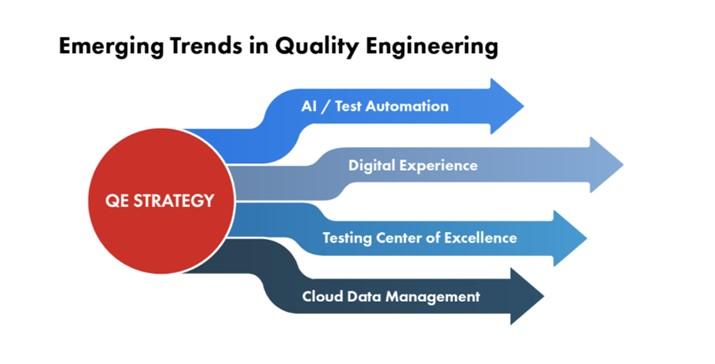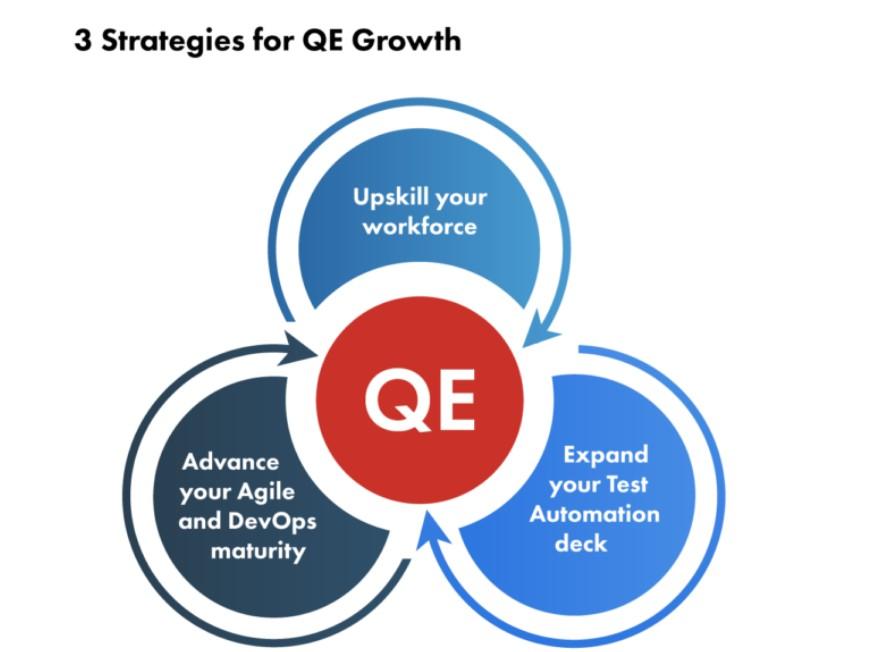Quality Engineering: Emerging Trends and Practices

The combination of necessity and the maturity of technology over the past few years has accelerated digital adoption. With digitally savvy customers expecting personalized products and services, quality engineering tools such as test automation become even more important to drive faster speed-to-market, customized products, and enhanced customer experience.
The global automation test market size is estimated to grow from USD 20.7 billion in 2021 to USD 49.9 billion by 2026, according to Research and Markets. This robust growth projection is demonstrative of not only the increased market availability of new technologies like AI and IoT, but also of how more and more organizations are embracing these advanced technologies to enhance the quality and performance of their core systems to power business growth.
To fully leverage the capabilities of test automation and drive the most benefits to your business, here are four emerging trends and best practices to help you define your QE strategy:

1. AI-based Analytics and Test Automation
Artificial intelligence is booming. According to Gartner, 40% of infrastructure and operation teams in large-sized companies will aim to enhance organizational efficiency through AI-augmented automation by 2023. AI-based analytics expand test coverage, reduce excessive test cases and scripts, and automate defect analysis.
Test automation makes it possible to eliminate most manual testing from the product cycle, reducing reliance on human intervention and management. AI-based tools promise improved software quality, reduced testing times, and faster speed-to-market. The resulting efficiency is a key competitive advantage that will increase as the technical possibilities in test automation continue to evolve.
2. Digital Experience
Digital transformation will further accelerate in the coming years. Global digital transformation spending, according to Statista, is on track to reach 2.4 trillion U.S. dollars by 2024. As customer experience becomes distributed across multiple digital channels, organizations find a greater need to validate and test the quality of each experience via API, security, and end-to-end user testing.
Improved digital experiences go hand-in-hand with the development of Agile and DevOps methodologies to maintain continuous testing and CI/CD tools for better quality and speed. Digital transformation is key to not only testing customer experiences that drive ROI, but to accommodate the growing “distributed Agile” that combine off-shore and on-shore deliveries.
3. Testing Center of Excellence (TCoE)
The increasing adoption of Agile and digital technologies are motivating organizations to modify their TcoEs. Initial TCoE structures relied on centralized testing delivery locations primarily focused on functional testing. Organizations, however, have started shifting to shared delivery and competency centers that service expanded capabilities, including functional and nonfunctional testing, as well as other technical services.
These client-dedicated TCoEs support both client server/web applications and digital technologies, providing expertise in continuous testing and DevOps automation, mobile applications, cloud and application migration, and more. Ultimately, they foster cross-functional teams that further streamline the testing cycle, mitigate risks, and reduce costs.
4. Cloud-Based Test Data Management
Enterprises that have embraced digital transformation also tend to shift their test environment and management to the Cloud. The global integrated cloud management platforms market size is expected to grow to $5.8 billion by 2027, according to Markets and Markets.
Though security hurdles and difficulties transitioning from siloed legacy systems exist, organizations are increasingly opting for a hybrid public and private cloud solution as the setting to conduct their QA/QE testing. As artificial intelligence, IoT sensors, and other new technologies further expand the capacity to collect data, cloud management platform solutions are helping enterprises optimize data storage and analytics for strategic edge and faster test reports.
Strategies to QE Growth
Adopting these trends requires each enterprise to familiarize themselves with approaches to QE and areas of testing, analyze their unique set of existing conditions, and choose the strategies to optimize their quality engineering.
There are three definitive steps to take to jumpstart your QE journey:

1. Advance your Agile/DevOps methodology toward maturity.
While many enterprises have started their transition to Agile, some still rely on Waterfall methods for non-digital projects. A shift-left approach, including initial methods, such as unit testing and static code analysis, can help enterprises attain maturity for their Agile and deploy further continuous testing and DevOps tools (CI/CD). A mature Agile/DevOps methodology sets the foundation for test automation, expanding the use of automation in development cycles to include both functional and nonfunctional testing.
2. Expand your Test Automation deck.
Test automation is central to a sound QE strategy, but enterprises are not yet utilizing its full capacity. As test environments transition to Cloud, AI-tools, such as Intelligent Data Lifecycle Automation, become critical to collect metadata, maintain data indexes, and streamline its organization for testing.
Enterprises should also expand their test automation to encompass nonfunctional testing, especially DevSecOps (application security testing). They can utilize static application security tools and dynamic application security testing to automate vulnerability scanning and identify security defects faster.
3. Find vendors to upskill and cross-skill your workforce.
QE is not only about employing the right technology in areas like Machine Learning (ML) and Natural Language Processing (NLP), but also the right people. Enterprises that already are dealing with staffing challenges need to find a way to quickly get people up-to-speed on the requisite QE skills.
Both high wages and resource scarcity hinder their capacity to develop specialized expertise to manage the expanded range of services expected for TCoEs. For that reason, enterprises should seek out vendors to partner with to create a sustainable plan for a skill refresh while also developing home-grown talent.
Applying these up-and-coming trends in quality engineering calls for a sustainable plan that combines the right investment, organizational shift, and applicable technology. Enterprises should strive for a solid foundation with a mature Agile/DevOps for digital projects, invest in advanced AI-tools and Cloud migration, and develop specialized expertise. Ultimately, a sound QE strategy incorporating these practices will achieve faster speed-to-market, reduced costs, and quality products that cater to evolving demands and market conditions.
Are you ready to tackle these trends and grow your QE? Contact our team to know more!



